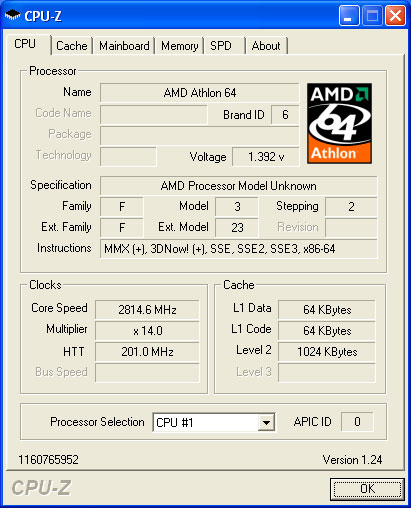AMD Athlon 64 FX-60: A Dual-Core farewell to Socket-939
by Anand Lal Shimpi on January 9, 2006 11:59 PM EST- Posted in
- CPUs
Final Words
The prospect of dual core usually meant that you had to give up some single-threaded performance, but with the Athlon 64 FX-60, that tradeoff is no longer true. While it's still not clocked as high as the fastest single core processor, it is extremely close. It's close enough that the difference in clock speed makes single-threaded performance a non-issue.
The fact that the FX-60 and FX-57 are almost at a clock speed parity is important because it does mean that we are getting beyond the inflection point of the dual core/single core transition. The high end dual core chips are all but caught up to the high end single core chips of just six months ago. Intel still has a little way to go before the same is true for them, but with the FX-60, it does hold true for AMD.
Unfortunately, since the FX-60 is still built on the same 90nm Toledo core as the previous X2 processors, overclocking headroom is not that great. With a retail AMD heatsink/fan, the best that we could do is 2.8GHz at 1.40V. With more exotic cooling, you could probably manage better, but stepping up the voltage all the way up to 1.50V wouldn't yield a 3GHz overclock on air.
Then there's the issue of AMD's upcoming Socket-AM2; due out in another few months, you obviously won't be able to use any Socket-939 processors in the new motherboards and there will be no upgrade path beyond the FX-60 for current 939 owners. So, our recommendation would be to stay away from the FX-60 unless you absolutely have to build the world's fastest system today.
If the latter is true, then you can't go wrong with the FX-60; if not, however, you'll be better off waiting for AM2.
The prospect of dual core usually meant that you had to give up some single-threaded performance, but with the Athlon 64 FX-60, that tradeoff is no longer true. While it's still not clocked as high as the fastest single core processor, it is extremely close. It's close enough that the difference in clock speed makes single-threaded performance a non-issue.
The fact that the FX-60 and FX-57 are almost at a clock speed parity is important because it does mean that we are getting beyond the inflection point of the dual core/single core transition. The high end dual core chips are all but caught up to the high end single core chips of just six months ago. Intel still has a little way to go before the same is true for them, but with the FX-60, it does hold true for AMD.
Unfortunately, since the FX-60 is still built on the same 90nm Toledo core as the previous X2 processors, overclocking headroom is not that great. With a retail AMD heatsink/fan, the best that we could do is 2.8GHz at 1.40V. With more exotic cooling, you could probably manage better, but stepping up the voltage all the way up to 1.50V wouldn't yield a 3GHz overclock on air.

Then there's the issue of AMD's upcoming Socket-AM2; due out in another few months, you obviously won't be able to use any Socket-939 processors in the new motherboards and there will be no upgrade path beyond the FX-60 for current 939 owners. So, our recommendation would be to stay away from the FX-60 unless you absolutely have to build the world's fastest system today.
If the latter is true, then you can't go wrong with the FX-60; if not, however, you'll be better off waiting for AM2.










94 Comments
View All Comments
latrosicarius - Tuesday, January 10, 2006 - link
Would have been funny too :-PFuren - Tuesday, January 10, 2006 - link
The key word is "faster"... AMD will continue producing socket 939 CPUs for a while yet, we just wont get any speed bumps, kind of like they did with socket 754. I thought we'd get an extra X2 on socket 939 though...Furen - Tuesday, January 10, 2006 - link
Is the FX-55 being retired? Or is it just getting a price drop?Anand Lal Shimpi - Tuesday, January 10, 2006 - link
Retired, only the FX-57 and 60 will remain on the market.Take care,
Anand
Rand - Tuesday, January 10, 2006 - link
I wish the gaming tests had been done at 640x480 so as to attempt to minimize the graphics cards influence on the results.Anand Lal Shimpi - Tuesday, January 10, 2006 - link
Normally I'm not in favor of running things at that low of a resolution, especially with this pricey of a graphics card, but I am looking at some other options for getting more useful gaming results. Who knows, it may not be too long before we have something in house that's a little less GPU bound to pair up with these ultra-fast CPUs :)I am also considering doing a high end CPU + SLI/Crossfire article to look at exactly what the CPU/GPU balance of today's games happens to be.
But to keep this post short - request heard and understood :)
Take care,
Anand
bob661 - Tuesday, January 10, 2006 - link
Aaawwwww sooky sooky!! Come on, give us a little more please!!!!
Questar - Tuesday, January 10, 2006 - link
How about using the D3D Null driver?Tytanium - Tuesday, January 10, 2006 - link
I would have liked to have seen it running at 14x200 so it had the same clock as an FX-57 though :/, for comparison's sake (dual core and all that)Anand Lal Shimpi - Tuesday, January 10, 2006 - link
We've done dual core vs. single core articles in the past that would be able to give you the answers you're looking for. While they weren't at 2.6GHz, their results are still applicable today.Take care,
Anand